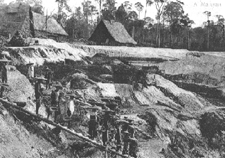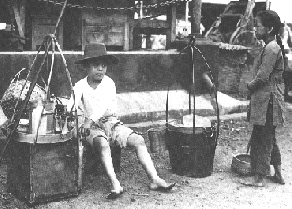|
Rebuilding Kuala Lumpur. Yap
Ah Loy's success in building Kuala Lumpur may have seemed
to be easy and inevitable. But in reality, it was a
desperately harsh struggle of which success was not
guaranteed.
The once prosperous Kuala
Lumpur was completely destroyed during the civil war.
When Davidson visited Kuala Lumpur in 1875. he wrote that
"most of the mines were completely flooded out
during the last war and all their mine houses, machinery
and property were burnt, or otherwise destroyed. After
the fighting was over they had to reconstruct their mines
with borrowed money which has not been paid off. Their
creditors are now pressing them and traders will scarcely
give them any credit."
The Chinese would have
abandoned the devastated Kuala Lumpur had not been for
Yap Ah Loy's persuasion and perseverance in rebuilding
Kuala Lumpur. Swettenham remarked that Yap Ah Loy's
"perseverance alone, I believe, has kept the Chinese
in the country."
In order to rebuild Kuala Lumpur and
restart tin mining,
Yap Ah Loy needed a large labour. With the restoration of
law and order, some Chinese had begun to return. Yap Ah
Loy also actively brought in labour from Klang, Sungei
Ujong and China. In early 1875, he brought in 2000 miners
from Klang and 600 from Sungei Ujong.
 |
Picture
of miners, the mine pit and their attap houses.
|
With a labourer
costing between $80-$100 annually in wages and food, and
the need for a year's maintenance before any money can be
recovered from the sale of tin, Yap Ah Loy faced severe
financial difficulties. Until 1879, the price of tin was
mired at the range of $50-60 per bahara, under the impact of new low cost production
in Australia.
Yap Ah Loy faced the two main
problems of raising the capital to finance mining and
reducing the costs of production by obtaining cheaper
supplies and improving communications. When the Malaccan
merchants took the opportunity to raise the prices of
supplies, Yap Ah Loy, with Davidson's sponsorship, began
to import supplies direct from Singapore. Davidson
arranged for a Selangor Government guarantee that enabled
Yap Ah Loy to purchase an initial supply worth $10,000
from Guthrie & Co. Although Yap Ah Loy undertook to
sell all his tin through Guthrie's, and to repay
Guthrie's loans with the sales proceeds, Yap Ah Loy in
effect repaid Guthrie's enough to maintain the loan
at $10,000 and sold the rest of the tin elsewhere.
| Financiers |
Interest Rates charged per annum |
| Malaccan
merchants |
18% |
| Guthrie
& Co. |
15% |
| Selangor
Government |
10% |
At the same time, Yap
Ah Loy encouraged the Malays to plant padi so that a
cheap local source of rice would be available to town's
population.
From 1875 to 1878, Yap Ah Loy became
increasing hard-pressed as tin prices remained low. In
1878, the Resident, Douglas, reported that "the
Captain China's power does hang by a thread as he is on
the verge of bankruptcy."
 |
| A
boy hawking his wares. |
By the middle of
1879, Yap Ah Loy's fortunes reversed when by less a
stroke of good luck and more a boom in the demand for
tin, tin prices doubled and rose above the $100 per bahara level. By mid 1880, Yap Ah Loy had paid off
all his debts and was never to be in financial distress
again.
Yap Ah Loy's success in rebuilding
Kuala Lumpur was confirmed by its naming as the state
capital in March 1880.
| 